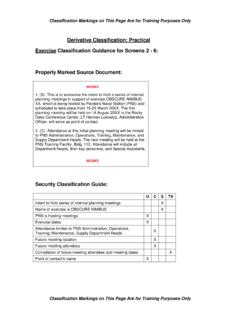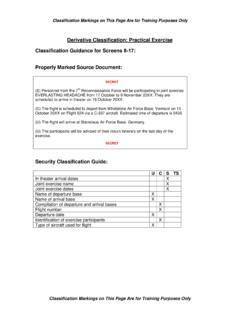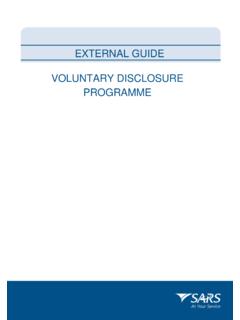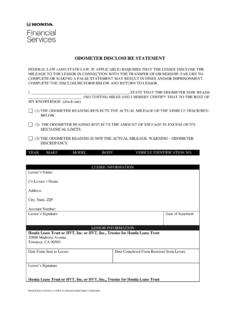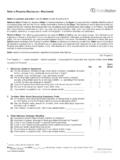Transcription of Student Guide Unauthorized Disclosure of …
1 Center for Development of Security Excellence Page 1 Student Guide Unauthorized Disclosure of classified information for DoD and Industry Lesson 1: What Is Unauthorized Disclosure ? Introduction Opening There are so many examples of how Unauthorized Disclosure of classified information has disrupted missions related to national security. And you ve got to wonder, you can one person hide from the for so long? But the answer often comes back to this: Unauthorized Disclosure , not only of classified information , but also of Controlled Unclassified information , or CUI. According to the 9/11 Commission Report, the Washington Times published a story in 1998 that made reference to the using Bin Laden s satellite phone to track his movements and communications.
2 The day after the article published, the phone went dark. Coincidence? Possibly. But more than likely it s not. Revealing a source and method in this case was potentially the reason the lost the ability to track Bin Laden. Through similar media leaks, the lost track of Al Qaeda s network of sites, Obelisk, which had provided the information about operational communications between Al Qaeda elements. The media leaks also caused the to lose access to terrorist financial networks. The Disclosure of this classified program led to a change in how terrorist financial networks operated, making it much more difficult to track and interrupt funding operations.
3 Objectives In this lesson, you will review what constitutes Unauthorized Disclosure , including specific types of Unauthorized Disclosure and some common misconceptions about Unauthorized Disclosure . You will also review the types of damage caused by Unauthorized Disclosure and the various sanctions you could face if caught engaging in Unauthorized Disclosure . Here are the lesson objectives: Unauthorized Disclosure of classified information for DoD and Industry Lesson 1: What Is Unauthorized Disclosure ? Student Guide Center for Development of Security Excellence Page 2 Identify types of Unauthorized Disclosure Recognize the impacts of Unauthorized Disclosure Overview of Unauthorized Disclosure Definition of Unauthorized Disclosure As defined in DoDM , Volume 3, DoD information Security Program, Unauthorized Disclosure is the communication or physical transfer of classified or controlled unclassified information to an Unauthorized recipient.
4 To understand who Unauthorized recipients are, let s first review who authorized recipients of classified information are. As a cleared employee, you should recall that authorized recipients must meet three requirements to access classified information . First, they must have a favorable determination of eligibility at the proper level for access to classified information . Second, they must have a need-to-know for access to classified information . And third, they must have signed an SF-312, classified information Nondisclosure Agreement (NDA), before accessing classified information . Therefore, if an individual has not met all three of these requirements, that individual would be considered an Unauthorized recipient of classified information .
5 Controlled unclassified information , or CUI, is unclassified information which requires safeguarding or dissemination controls in accordance with applicable laws, regulations, and government policies. Although a personnel security clearance is not required to access CUI, dissemination of and access to CUI requires practice of need-to-know principles and may be subject to additional limitations, such as unique transmission requirements or export controls. CUI includes but is not limited to information designated as: For Official Use Only (FOUO) Law Enforcement Sensitive (LES), LIMITED DISTRIBUTION (LIMDIS) An Unauthorized recipient can be anyone.
6 They can be your friends or family members, acquaintances, coworkers, or even superiors within your agency, command, or company who may be appropriately cleared but don t have a need-to-know. They can be potential employers who see what you post on social network sites such as LinkedIn and Facebook. They can even be media outlets and foreign intelligence services. You never know whose hands such information will fall into. Types of Unauthorized Disclosure Unauthorized Disclosure can involve either classified information or CUI. When classified information is involved, Unauthorized Disclosure can be categorized as a Unauthorized Disclosure of classified information for DoD and Industry Lesson 1: What Is Unauthorized Disclosure ?
7 Student Guide Center for Development of Security Excellence Page 3 type of security incident, characterized as an infraction or violation depending on the seriousness of the incident. Unauthorized Disclosure can happen in various ways. It can be disclosed either intentionally or accidentally and can occur through leaks, spills, espionage, or not following proper safeguarding procedures. Leaks Leaks are deliberate disclosures of information to the media. W ell-known examples of leaks include leaks of information regarding top secret government surveillance programs to news outlets and Bradley Manning s leaks of hundreds of thousands of classified documents, such as diplomatic cables and Army reports, to the WikiLeaks website.
8 Spills Data spills are willful, negligent, or inadvertent disclosures of information . They occur when classified information or CUI is transferred or transmitted onto a system that lacks the appropriate security level or, in the case of CUI, that lacks the required protection or access controls. For example, if classified information from the secure internet protocol router network, or SIPRNet, is opened on the non-secure internet protocol router network, or NIPRNet, then a spill has occurred. Spills like this can create the potential for widespread Unauthorized Disclosure of information in a relatively short amount of time. The impacts of these spills can be so severe when classified information is involved that a new term is applied: Negligent Discharge of classified information , or NDCI, which is based on the familiar firearms term Negligent Discharge to connote its seriousness.
9 Until it can be determined whether an Unauthorized Disclosure occurred, NDCIs are considered and handled as a possible compromise of classified information involving information systems, networks, and computer equipment. The most common ways that spills happen are through email and Internet postings. The classified information could be in the body of the email, in an attachment to the email, or both. Even if individually all elements are unclassified, sometimes the compilation of the body of the email and the attachment results in Disclosure of classified information . Similarly, posting CUI and other unclassified defense and Government information data elements to publicly accessible Internet sites can jeopardize militarily-relevant data because when compiled together the information could become classified , which is known as a classified compilation.
10 Be careful of what CUI and other unclassified defense and Government information you send in an email and post on the Internet to avoid classified compilations for public access. Unauthorized Disclosure of classified information for DoD and Industry Lesson 1: What Is Unauthorized Disclosure ? Student Guide Center for Development of Security Excellence Page 4 Remember that CUI may not be posted to publicly-accessible websites, and different types of CUI may require additional posting restrictions. Espionage Espionage includes activities designed to obtain, deliver, communicate, or transmit information relating to the national defense with the intent or reason to believe such information will be used to harm the United States or to the advantage of a foreign nation or transnational entity.



